This website is supported by its readers. If you click one of my links I may earn a commission. I am also a participant in the Amazon affiliates program and I will also earn a commission from qualified purchases.
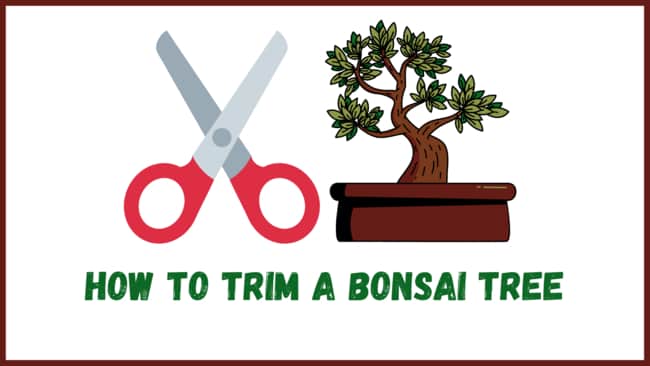
One of the most exciting parts about keeping bonsai trees is the fun that comes along with trimming and pruning your tree. That being said, a few wrong cuts on a miniature bonsai tree can lead to disaster, making for a less aesthetic tree at best and a dead tree at worse. So how exactly do you trim a bonsai tree?
To trim a bonsai tree, ensure it’s the right time of year, and then use a sharp pair of shears to trim your bonsai branches back to 2 to 3 leaves. New shoots will grow from trimmed leaves, giving a more visually pleasing bonsai.
So what is the exact step-by-step process of trimming your bonsai tree? Are there different types of trimming required for bonsai trees? Keep reading to find out more!
Just a quick heads up, over the past three years of running Plantpaladin, hundreds of people have asked for product recommendations. As such, You can find my favorite indoor bonsai tree here (link takes you to Bonsaiboy), my favorite outdoor bonsai tree (link takes you to Bonsaiboy), or have a look at all the products I recommend here.
Trim a bonsai tree
One of the major problems I ran into when I first started keeping bonsai trees a few years back, regardless of species was trimming my bonsai trees.
I always seemed to trim my trees too high up on the branches and could never quite get my tree to look exactly the way I wanted it to.
It’s safe to say I killed a few bonsai trees in the process!
That being said, after a few years of trial and error and speaking to a few bonsai experts I have managed to get the process down.
No double a lot of you new to bonsai will also be struggling with the same so I visited my local botanical gardens and undertook a quick survey of Plant Paladin readers to provide the most comprehensive guide on how to trim a bonsai tree.
To summarize:
Trim a bonsai tree – quick facts
- Trimming a bonsai tree is essential to maintain a bonsai tree that looks like a miniature tree
- There are two main types of trimming, structural trimming which drastically changes the shape of your tree, and maintenance trimming, which is done regularly to maintain the shape of your tree.
- To trim a bonsai, use a sharp pair of scissors or shears and trim back the branches of your tree.
- Ideally, you want to aim to trim the branches back until 2 to 3 leaves are left on the branch.
- This will force new growth to grow out of the buds located near the remaining leaves, causing new directions of growth and new branches to occur.
- Trimming branches in this way can result in a denser leaf canopy and more bonsai ramification – both of which lead to a more aesthetically pleasing tree.
- Bonsai trees that have needle/tip-like leaves such as Scots Pine or Juniper trees should be trimmed by hand by picking the leaves
- Alongside the branches and leaves of a bonsai that need to be pruned, the roots of your bonsai tree will also need to be trimmed.
Now trimming a bonsai tree is a very in-depth process so we will dive into more detail on all the factors that go into trimming a bonsai in the rest of the post.
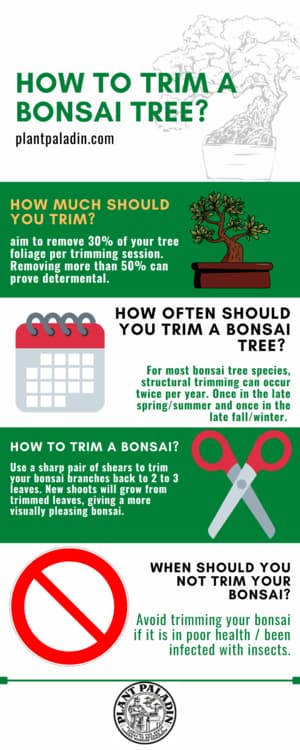
What tools do you need to trim a bonsai?
To trim a bonsai you will need either a sharp pair of scissors or bespoke garden trimming shears. Branch cutters may also be needed if you have an older bonsai tree with thicker branches.
Now whilst a sharp pair of scissors will work well for most of you, hopefully, the list below will help go into more detail on what the best equipment is and why:
- Scissors – This will be your go-to tool and most of you will have these lying around the house. Ideal for medium-sized trees however you may have some difficulty with smaller trees that have smaller branches.
- Bonsai shears – Bespoke bonsai shears are fantastic at removing branches in smaller trees that have more branches and a lot of hard-to-reach areas.
- Branch cutters – If you have thicker branches on your tree that your scissors or sheers are not able to remove then branch customers will be your best bet, concave branch cutters can also work wonders on older, tougher trees.
- Gloves – You should always take precautions when using sharp blades, as such, using gloves will mean you won’t have to worry about getting cut.
- Turntable – This will make the process of moving your bonsai tree around as you look for branches to cut easier.
- Root hook – Needed to remove your bonsai from its pot when trimming the roots of your bonsai tree.
When to trim a bonsai tree?
The best time to undertake structural or directional trimming of your bonsai tree will be in the late spring/summer once your bonsai trees leaves have hardened and your tree has more energy in them which can promote new growth.
Maintainance pruning whereby you remove a few leaves and branches can be undertaken at any time of the year so long as you are not removing too many leaves/branches.
That being said, the timings of when you trim bonsai trees are a little bit more complicated than saying to trim your bonsai tree in the spring.
Hopefully, the table below will help summarize but let’s go into more detail about the different seasons:
Season | Should you trim |
Spring | Only in the late spring once the leaves have grown and hardened |
Summer | Yes |
Fall | Only once the leaves have dropped |
Winter | Yes |
Trim a bonsai tree in the spring
So whilst spring is often the go-to month for starting work on bonsai trees (it’s one of the reasons why repotting, wiring, and plating are all recommended in the spring) when it comes to trimming your bonsai tree it is a little bit of a different story.
Deciduous species and deciduous-like species such as Chinese Elm should be pruned in the late spring – typically around April/May.
This is because in the first few weeks of spring the tree’s energy level is low as it utilizes its energy in pushing out new leaf growth.
As such, pruning early in the spring will not be ideal.
Instead, wait to prune your tree in spring until the leaves have grown and hardened.
Even trimming conifers in the early spring can prove problematic and messy to say the least with species like Juniper and Pine species often having a lot more sap in the tree, in the earlier parts of the spring.
Trim a bonsai in the summer
Summer is the ideal time of year to do heavy branch trimming on a bonsai tree, regardless of if it is a conifer or deciduous variety.
Most of the growth will have occurred meaning your tree’s energy reserves will be at it’s highest.
This means that your tree can spend the majority of its time in the summer focused on healing from the trimming that you have undertaken and help grow out the new branches you are trying to create.
Conifers too tend to have less sap in them in the summer making them a lot easier to work with.
Trim a bonsai in the fall
During the fall, the energy level in trees tends to drop a little and your tree will have a medium energy level.
As such, you can work on trimming your bonsai tree at this point in the year, however, during the fall, just before the leaf falls your tree will be spending a lot of its energy trying to store as much of the synthesized carbohydrates it has absorbed through photosynthesis as possible.
This will prevent any new bud growth from occurring before the leaves fall.
As such, only trim your bonsai tree in the fall, once the leaves have dropped from your tree.
Trim a bonsai in winter
During the winter, surprisingly, energy levels in deciduous trees tend to rise as all the energy ends up becoming stored in the trunk and branches.
This is mainly due to there being fewer leaves on the tree for your bonsai to maintain, meaning its energy levels increase.
As such, this is a fairly good time to trim your bonsai tree.
How often should you trim a bonsai tree?
For most bonsai tree species, structural trimming can occur twice per year. Once in the late spring/summer and once in the late fall/winter. Maintenance trimming where you only remove a few branches at a time can be done every few weeks.
How often should you trim a bonsai tree indoors?
You can structurally trim your bonsai tree 3 to 4 times per year if you keep it indoors in a strict temperature-controlled climate. This is because you can maintain the energy levels much easier in trees that are kept indoors.
Maintenance trimming can also be undertaken every few weeks should you keep your bonsai tree indoors.
How to trim a bonsai tree?
So now you know what tools you need to trim your bonsai tree and what time of year to trim your tree it’s time to start the fun process of actually trimming your tree!
There are 2 main methods for trimming your bonsai tree:
- Structural/directional trimming
- Maintenance trimming
Let’s explore these in more detail
Maintenance trimming
Maintenance trimming is the type of trimming you will do most often.
For this type of trimming, you won’t be taking out huge chunks of branches and leaves from your bonsai tree.
The purpose of maintenance trimming is to remove the growth on the top of stems as well as the outer parts of a bonsai tree to refine the shape of the tree.
Any excess leaves or branches then that are overtaking the size or style of your bonsai tree will need to be removed.
This will help encourage growth in the inner part of the tree.
For example, let’s say you want to frow out a Chinese Elm bonsai tree into the Cascade style.
Any branches that are overly distracting to the silhouette, size, and shape of the cascade style then will need to be removed.
Maintenance pruning can also be useful for removing any dead stems, branches, and leaves that might have occurred in between trimming sessions.
Maintenance trimming is also useful to remove any branches that cross over other branches.
Branches that crossover typically lead to a less aesthetically pleasing bonsai tree and should be removed in most circumstances.
This type of trimming can be undertaken fairly frequently every few weeks.
How to maintenance trim a bonsai tree?
To maintenance trim a bonsai tree, grab the branch/twig that you will be removing from your tree between your index and middle finger.
Then pull this towards you.
Once in hand, use the shears to trim until the stem/branch fits the look of the tree.
You can then repeat this process throughout the tree, using a turntable to get into any hard-to-reach spots.
For conifers that have needle-like leaves, you can still prune excess branches that are growing out, however, to remove any excess foliage, use your finger to pinch the excess foliage.
Do this by holding the tips between your index finger and thumb.
Then push away, the twigs then will snap at the weak point and you won’t have to worry about damaging your bonsai.
This type of trimming is also good for spotting branches that are pointing upwards, removing these types of branches will prevent upward growth that can be hard to control if left unchecked.
Structural trimming
So structural trimming (also known as direction trimming) is the more severe trimming that you will only do a few times per year.
The idea of this type of trimming is to make significant cuts in your tree, to change the structure and appearance of your tree.
It is called directional trimming as you are trimming back the branches to create new branches/growth in new directions.
This generally helps with creating more leaves through defoliation and can significantly improve a bonsai tree’s ramification.
An example of this would be cutting back a sacrifice branch that you have grown out for the past 3 years.
Doing this will make a huge difference to the look of your tree.
Structural trimming then is most often done with larger branches.
Just be aware that structural trimming can leave scars on your rees due to trimming larger branches.
As such, using a concave cutter or other tools can prove beneficial in reducing the amount of scaring on your bonsai.
How much of my bonsai tree should I trim?
When undertaking structural trimming aim to remove 30% of your tree foliage per trimming session. Removing more than 50% of your bonsai tree’s branches, leaves and twigs can cause a shock in your tree that can weaken its health.
How to structurally trim a bonsai tree?
Now structurally trimming a bonsai tree is a little tricker than maintenance trimming so follow these steps for best results:
Draw out your tree
If this is the first time you are undertaking structural trimming, I would highly recommend starting by using a pen and paper to draw a rough layout of what your existing tree looks like.
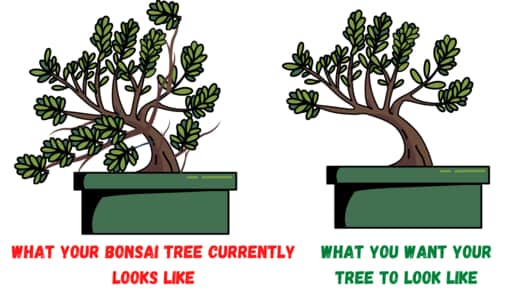
Then draw a second image of a rough idea of what you want your tree to look like.
This will help give you something to aim for, making you feel confident in your choices of the branches you chose to remove.
After a few times doing this, you will no longer need to draw up your design as it will become second nature.
Remove any dead branches using maintenance trimming
Next, using the steps we laid out previously, inspect your bonsai tree for signs of overgrown leaves or dead branches that impact your bonsai trees silhouette.
This would be a good stage to remove any excess growth that might have occurred on your tree.
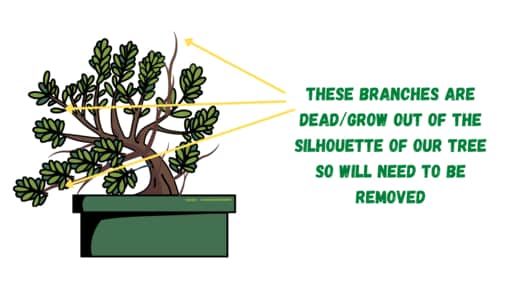
Look for branches to trim back
Now you have trimmed back a lot of the dead material, start by observing any branches that stand out and need trimming.
A good example here would be:
- Branches that cross over other branches.
- Branches that face upwards.
- Stems that are growing directly from the lower trunk. that impact how your trees look.
These branches are ones that you do not want to grow any further and should be trimmed back as close to the branch/trunk as possible.
Hopefully, the image below will help show you what to look out for:
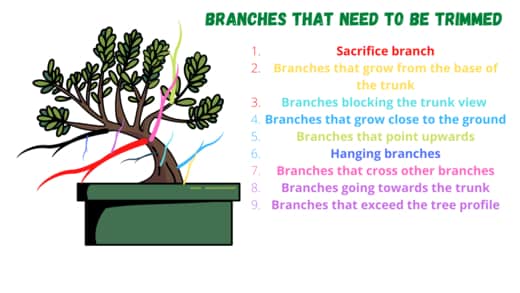
Start directional trimming
Once all the easy branches have been trimmed back it’s time to start thinking about new growth.
Look at the remaining large branches from your tree.
Any branches that have long growth or require trimming back to create secondary or tertiary branches are ideal here.
Select a branch then that you want to trim back.
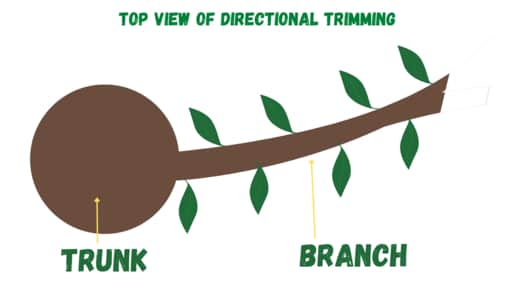
Then aim to trim this branch back until only 2 to 3 leaves are remaining on the branch.
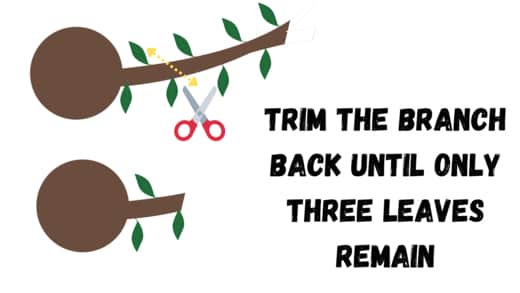
Now, these 2-3 new leaves will have a new bud underneath them waiting to sprout and grow.
Pruning your branches back to 2-3 leaves will force the raming auxins in your branch to send a signal to the leaves to start new growth where the remains leaves are.
This then can create secondary and tertiary branches in your tree.
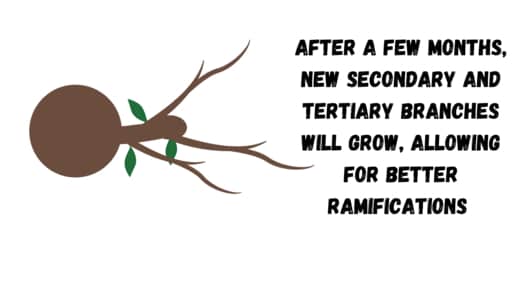
You can then repeat this process in your secondary and tertiary branches to add even more ramifications to your tree.
Cover any wounds
Once you have trimmed the branches of your bonsai tree there will likely be a lot of cuts and wounds in your tree.
If left exposed these can be at risk of infections.
As such, ensure you cover any gashes and wounds with wound paste to protect your bonsai.
Water your tree
Once your trimming has been completed and you have got rid of any wounds, immediately start watering your tree to send a signal to start the new growth.
Let your tree grow
Once you have completed the structural pruning, you must give your bonsai tree a few months to rest and recover.
This will allow the branches that you have just trimmed to strengthen and establish new growth.
Maintain correct aftercare of fertilizer, sunlight, and temperature requirements depending on your species.
Why trim a bonsai tree?
So whilst trimming a bonsai tree is something all of us do, what are the exact reasons why people trim a bonsai tree?
Well, the main reasons include:
Achieving different styles
No two bonsai tree styles are alike with styles such as sumo, cascade, and informal upright all varying drastically from each other.
As such, trimming will be required to achieve specific desired looks.
Reduce leaf size
Bonsai trees aim to replicate miniature trees.
Without trimming or pruning, you will just end up with a shrub that has large leaves.
Trimming your tree can ensure that your leaves stay small, making sure your bonsai tree resembles a miniature tree.
Creates more branches and ramifications
Trimming and cutting the branches of your bonsai tree can add more branches and ramifications to your tree.
The ramification is just a branch that has secondary and tertiary branches.,
Having a bonsai tree then that has been trimmed will allow it to resemble a miniature tree much better than a bonsai tree you did not trim.
Reduces the size of upper branches
Bonsai trees have a habit of growing their branches in different sizes.
A super common problem then that occurs is sometimes branches that are higher up tend to have a lot of width to them – in some instances even rivaling the thickness of the trunk of your bonsai.
Removing these upper branches that are thicker will help keep a more visually pleasing bonsai tree.
Removes sacrifice branches
These are branches that are grown over the space of three to five years to thicken up the trunk of a bonsai tree.
Without trimming a bonsai tree these sacrifice branches will naturally become overly large and will distract from the look of your bonsai tree.
Creates trunk taper
Most bonsai trees that stand out have a great taper.
This is just a fancy way of saying they are wider near the base of the bonsai tree and thinner the higher up the tree you go.
Trimming any excess branches that are thicker and distract from the size and style of tree you are going for will help create taper over time, adding girth to the trunk of your tree.
Reduces the size of upper branches
Similar to the point above, the higher up a bonsai tree you go, the thinner the branches tend to be.
Without trimming the upper branches of your bonsai would just grow continuously causing an irregular-shaped bonsai tree.
Reduce branches that cross over each other
A go-to sign of a messy bonsai tree is branches that overlap each other.
This can be distracting.
One of the reasons then for trimming a bonsai tree is to reduce any branches that cross over, are dead, or any branches that are visually unappealing to your overall design.
What to avoid when trimming your bonsai tree?
So whilst all of us would like to say that we will do a fantastic job at trimming our bonsai tree, the truth is that if this is your first time, it’s likely you’re going to make a few mistakes.
These include:
Using blunt blades
If the shears or scissors that you use for your trimming are blunt, this can lead to you applying more force to remove your branches.
This can lead to a lot of scares and unnecessary cuts on your tree.
Pruning your tree at the wrong time of year
As mentioned earlier, most deciduous trees should only be pruned in the late spring and early summer.
Pruning your tree at the wrong time of year will cause a lot of stress in your tree as it tries to recover from the process.
Not trimming your branches back far enough
If you are undertaking structural trimming, then it is important to trim the branch back farther back than you might be comfortable with.
In most cases, trimming a bonsai branch back until only two or three leaves remain will give you the best results and have the best chance of transforming into great ramification.
Cracking your branches
A common problem a lot of people have when it comes to trimming their bonsai trees is that the tree branches or bark can sometimes crack.
If this happens to you fret not.
Simply spray the cracked branch with water, cover in moss ( sphagnum moss works well), and then cover in a black bag until the crack heals.
Alternatively using something like glue or putty that can hold any cracks together can help save your tree.
Trimming your bonsai when it is weak
Finally, you should avoid trimming your bonsai tree if it is weak.
If then you have found that your bonsai tree has recently had an insect infestation (aphids, scale, and spider mites are the most common) or if your tree has been attacked by a rabbit or squirrel then avoid trimming your tree.
On top of this, if you keep a fruiting bonsai or bonsai tree with flowers, I would avoid trimming your tree when it starts to flower/fruit – regardless of the time of year.
Your tree will be using a lot of energy to produce flowers and leaves which will make it more susceptible to illness.
The only caveat to this would be if your tree has a mold infection.
If this is the case, it would be wise to remove all the leaves from your tree to prevent the infection from spreading.
How to trim the roots of your bonsai tree
So whilst the vast majority of you will be reading this to trim your bonsai tree branches, some of you will be curious to trim your roots.
Now, this is best found in my post about repotting bonsai trees however to summarize:
- Use a root hook to pry your bonsai tree out of its pot.
- Use the root hook to remove any excess soil from the roots.
- Trim back about 30% of the roots on your tree – this includes the feeder roots.
- Repot your bonsai tree.
Survey on trimming a bonsai tree?
Finally, I undertook a quick survey of 20 plant paladin readers and asked them how frequently they undertake structural trimming on their trees.
Here were the results:
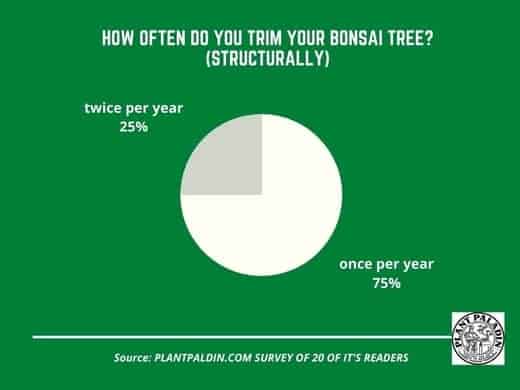
My top picks for the gear you will need!
So like I mentioned earlier, over the past three years of running PlantPaladin, hundreds of people have asked me for my recommendations on the best bonsai gear on the market.
Having spent thousands of dollars on bonsai items these past few years and tested at least 100 bonsai-specific products, I’ve listed my favorite products below – All of which I highly recommend and think you can get great value.
They can purchase directly by clicking the link to take them to Amazon.
Bonsai Tool Set: One of the significant challenges I’ve had is finding a toolset that was not only durable but didn’t break the bank. SOLIGT has recently developed a fantastic bonsai tool set that covers all the tools you need to trim, prune, and repot your trees. – You can grab it here.
Complete Bonsai Set: Many of you will want to grow your bonsai trees entirely from scratch, but finding the varicose seeds, pots, and other items in one place can be challenging. Leaves and Sole then have created a complete bonsai set that I’ve personally used that ticks all the boxes. You can grab it here.
Bonsai wire: The number of times I’ve run out of wire for my bonsai or purchased cheap bonsai wire that doesn’t do the job is embarrassing for me to admit. After a lot of trial and error, I found that using Hotop’s aluminum bonsai wire is one of the best options on the market. This can easily be used for both indoor and outdoor bonsai. You can grab it here.
